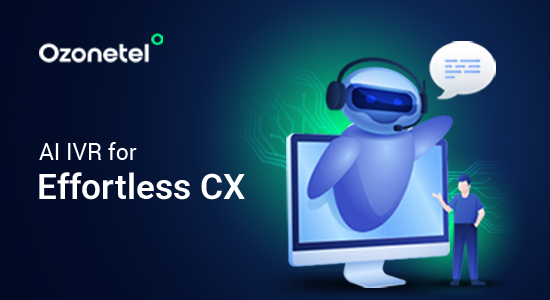- Resources
- The Ultimate Guide to Ecommerce Customer Service in 2025
The Ultimate Guide to Ecommerce Customer Service in 2025

Ecommerce brands spend millions on marketing, but many lose customers because of poor customer service. Long response times, unanswered queries, and frustrating return processes push buyers straight to competitors.
Customer expectations in 2025 are higher than ever—they want instant solutions, real-time order tracking, and personalized customer support across multiple platforms. You need a strategy that blends automation with human support to build trust and drive repeat business.
This guide covers everything you need to know about ecommerce customer service in 2025—why it matters, how to implement it effectively, and the best tools to get it right.
In this article, we will explore:
- 1.What is Ecommerce Customer Service?
- 2. How to Deploy Customer Support for Ecommerce (Best Practices)
- 3.7 Benefits of Ecommerce Customer Service
- 4.How to Measure Ecommerce Customer Service Success?
- 5.How AI and Automation Can Improve Ecommerce Customer Service
- 6.Examples of Excellent Customer Service in Ecommerce
- 7.Boost Your Ecommerce Customer Service with Ozonetel
What is Employee Experience?
Employee Experience (EX) is the overall perception employees have of their journey within an organization. It encompasses every interaction and touchpoint, from recruitment and onboarding to daily responsibilities, support systems, and eventual offboarding.
What is Ecommerce Customer Service?
Ecommerce customer service is the support you provide to customers throughout their online shopping journey—from product discovery to post-purchase assistance. Unlike traditional retail, where customers interact with store representatives in person, ecommerce support is handled across multiple digital channels, including email, phone, social media, and modern solutions like live chat & voice bots.
How Does Ecommerce Support Differ from Brick-and-Mortar Support?
Ecommerce customer service differs significantly from in-store support due to the nature of digital shopping. Here’s how:
| Aspect | Brick & Mortar | Ecommerce |
|---|---|---|
| Speed and Availability | Limited to store hours; immediate in-person assistance. | 24/7 support expected; live chat and AI chatbots provide instant responses. |
| Customer Interaction | Face-to-face communication helps read emotions and resolve concerns on the spot. | Requires multi-channel support (chat, email, social, etc.) across time zones. |
| Pre-Purchase Expectations | Physical product inspection reduces dependency on support. | Shoppers rely on visuals; need detailed product info and fast resolution to queries. |
| Personalization & Engagement | Personalized through direct human interaction | Powered by AI and CRM tools; based on user behavior and preferences. |
| Returns & Issue Resolution | In-store returns are simpler and quicker. | Involves logistics, refunds, and support; clear return policies and proactive communication are essential. |
How to Deploy Customer Support for Ecommerce (Best Practices)

Setting up customer support for ecommerce requires a structured approach that balances efficiency, personalization, and automation.
Here’s how to implement a scalable and effective support system for ecommerce:
1. Identify Preferred Support Channels
Analyze customer interactions to determine the most effective support channels—live chat, email, social media, voicebot, or phone.
- Website analytics to track where users seek help.
- Customer surveys to identify channel preferences.
- Historical data to understand peak inquiry times and recurring issues.
Once identified, optimize response times across these channels and set clear expectations on resolution timelines.
2. Implement Live Chat, and AI Chatbots
Integrate live chat as the primary support channel for instant query resolution. To scale efficiently:
- for FAQs, order tracking, and basic troubleshooting.
- Enable agent escalation for complex issues to ensure seamless handoffs.
- Deploy chat availability settings based on business hours or peak sales periods.
Pro Tip: Use chat transcripts to improve responses and train AI for better self-service capabilities.
3. Enable Self-Service Options
Reduce customer support load by empowering customers to find answers independently. Effective self-service not only enhances satisfaction but also reduces resolution time. Some key methods include:
- A structured knowledge base with categorized FAQs, return policies, and order tracking guides
- Automated help widgets that suggest solutions based on keywords in customer complaints
- Video tutorials or step-by-step walkthroughs for product setup and troubleshooting
- Voicebots or self-service chatbots for 24/7 assistance
4. Set Up an SLA-Driven Ticketing System
Use a ticketing system to manage queries efficiently. Integrate CRM data into the ticketing system for a holistic view of customer interactions. But, when doing this, ensure:
- Automated ticket routing to the right department based on query type.
- Response time SLAs (e.g., reply within 24 hours for general inquiries, 1 hour for urgent issues).
- Canned responses for common questions while allowing agents to personalize replies.
5. Personalize Customer Interactions
Move beyond scripted responses to create personalized customer experiences. Some ways to do this are:
- Using customer purchase history to tailor responses (e.g., product recommendations).
- Addressing customers by name and acknowledging past interactions.
- Implementing post-purchase follow-ups via email or SMS to check on satisfaction.
6. Actively Manage Customer Reviews
A proactive approach to customer reviews buils brand trust and enhances customer retention. Therefore
, monitor product and service reviews across platforms and respond strategically:
- Acknowledge all reviews—thank customers for positive feedback and address concerns professionally.
- Offer quick resolutions for negative reviews (e.g., refunds, replacements, or clarifications).
- Use review insights to improve support operations and product offerings.
7. Automate Order and Shipping Updates
Automation ensures customers stay informed without needing to contact support. Minimize support tickets related to order tracking by:
- Sending automated order status updates via email, SMS, or WhatsApp.
- Offering real-time tracking through your website or app.
- Providing self-service order modifications (e.g., address changes, cancellations).
8. Reward Loyal Customers with Exclusive Support
Loyalty-driven support encourages repeat business and strengthens brand relationships. You can enhance customer retention by offering VIP support to repeat buyers, such as:
- Priority support for high-value customers (e.g., faster response times).
- Exclusive customer service hotlines or dedicated account managers.
- Personalized discounts or loyalty perks based on purchase history.
7 Benefits of Ecommerce Customer Service

With rising competition and customer expectations, having a strong customer support system is essential for sustaining and growing your business. Here are the key benefits of prioritizing customer service in eCommerce:
1. Improves Customer Satisfaction
Customers expect quick, helpful responses when they have questions or face issues while shopping online. A responsive support system that includes live chat, email, social media, voicebot, CXi switch and self-service options (such as FAQs and chatbots) helps resolve problems efficiently.
- Faster resolution times: Customers value their time, and businesses that provide prompt responses build trust.
- Personalized support: Addressing customers by name and offering tailored solutions increases satisfaction.
- Higher CSAT scores: (Customer Satisfaction Score) Effective customer service ensures customers leave with a positive impression, encouraging repeat purchases.
2. Boosts Customer Loyalty and Retention
Retaining existing customers is more cost-effective than acquiring new ones. High-quality customer service helps build long-term relationships by ensuring customers feel valued and supported.
- Higher retention rates:
- Fosters emotional connections: Customers who feel appreciated and well-assisted are more likely to stay loyal to your brand.
- Reduces churn: Addressing concerns effectively prevents customers from switching to competitors.
3. Strengthens Brand Reputation
Positive customer experiences lead to stronger brand perception and trust. Satisfied customers share their experiences through reviews, testimonials, and word-of-mouth recommendations, which attract new buyers.
- Encourages positive reviews: Customers who receive excellent support are more likely to leave favorable feedback.
- Increases word-of-mouth marketing: Happy customers share their experiences with friends and family, bringing in more potential buyers.
- Enhances credibility: A brand known for exceptional customer service stands out in a crowded market.
4. Increases Revenue and Conversions
A well-structured customer service system directly impacts sales by assisting customers throughout their buying journey, reducing friction, and addressing objections.
- Higher conversion rates: Quick support can resolve doubts that prevent customers from completing their purchases.
- Encourages upselling and cross-selling: A knowledgeable support team can recommend relevant products based on customer needs.
- Increases lifetime value (LTV): Customers who stay longer tend to spend more over time, making retention a key driver of customer lifetime value.
5. Reduces Operational Costs
Investing in proactive customer support solutions minimizes repetitive inquiries and improves efficiency.
- Self-service options lower workload: FAQs, knowledge bases, voicebots, and AI-powered chatbots reduce the need for human intervention.
- Prevents costly returns and disputes: Clear communication and problem resolution reduce refund requests and chargebacks.
- Optimizes staffing costs: Efficient customer support tools allow businesses to manage inquiries with fewer resources.
6. Enhances Competitive Advantage
With numerous eCommerce businesses competing for attention, superior customer service sets you apart from the rest.
- Differentiates your brand: Exceptional service creates a reason for customers to choose you over competitors.
- Builds long-term trust: Consistently helpful and responsive support makes your brand more reliable in the eyes of customers.
- Encourages repeat business: Customers who receive outstanding service are more likely to return, increasing your market share.
7. Provides Valuable Customer Insights
Customer service interactions provide direct insights into pain points, preferences, and expectations.
- Identifies common issues: Tracking customer complaints helps improve products and services.
- Informs business decisions: Customer feedback reveals trends and areas for improvement.
- Optimizes marketing efforts: Understanding customer concerns helps tailor messaging and promotions.
How to Measure Ecommerce Customer Service Success?
To know if your support efforts are working, you need to track specific metrics that reveal how well your team is performing and where improvements are needed. Here’s a detailed breakdown of the key metrics that will give you a clear picture of your customer service success.
1. Customer Satisfaction Score (CSAT)
Customer satisfaction score (CSAT) tells you how happy customers are with the support they received. After a support interaction, customers are typically asked to rate their experience, usually on a scale from 1 to 5 or 1 to 10. The percentage of positive responses (4s and 5s or 8s and 10s) gives you your CSAT score.
To get meaningful insights:
- Send post-support surveys immediately after a conversation via email, chat, or SMS.
- Analyze feedback to identify common complaints and recurring service issues.
- Compare your CSAT against industry benchmarks (e.g., the average CSAT for ecommerce call centers is around 80%).
2. First Response Time (FRT) and Average Response Time (ART)
Customers expect quick answers, and long wait times lead to frustration and abandoned purchases. These two metrics help you measure speed:
- First Response Time (FRT): The time taken to send an initial reply after a customer contacts support.
- Average Response Time (ART): The time it takes to resolve a customer issue, including follow-ups.
To improve response times:
- Use automation, such as chatbots, voicebots, and CXi Switch to handle basic queries instantly.
- Set up auto-replies to acknowledge customer messages and provide estimated wait times.
- Prioritize urgent issues like payment failures and delivery concerns.
3. First Contact Resolution (FCR) Rate
First Contact Resolution (FCR) measures the percentage of issues resolved in the first interaction, without requiring follow-ups. The higher this number, the better your support team is at providing accurate and complete solutions.
To improve FCR:
- Train agents to handle a wide range of issues effectively.
- Provide a centralized knowledge base so customers and agents can access clear, accurate information.
- Track repeat queries and optimize responses to reduce back-and-forth conversations.
4. Net Promoter Score (NPS)
Net Promoter Score (NPS) shows how likely customers are to recommend your business. Customers are asked a simple question: “On a scale of 0 to 10, how likely are you to recommend us?”
- Promoters (9-10): Highly satisfied customers who will likely refer others.
- Passives (7-8): Neutral customers who may not actively promote or criticize.
- Detractors (0-6): Unhappy customers who may leave negative reviews.
To improve NPS:
- Address recurring complaints identified in CSAT and FCR analysis.
- Provide proactive customer support, such as reaching out to customers who faced issues.
- Offer personalized experiences based on past interactions and preferences.
5. Customer Effort Score (CES)
Customer Effort Score (CES) measures how easy it is for customers to get help. If they have to struggle to find support or get an issue resolved, they’re less likely to return.
To improve CES:
- Streamline self-service options like FAQs and automated order tracking.
- Reduce the number of steps required to resolve common issues.
- Offer omnichannel customer support on ecommerce sites so customers can switch between chat, email, and phone without repeating information.
6. Support Ticket Volume and Resolution Trends
Tracking the number of support tickets can help you understand customer pain points. A sudden increase in tickets may indicate a problem with a new product, a pricing issue, or a system failure.
To manage ticket volume effectively:
- Identify recurring complaints and address their root causes.
- Use AI-powered tools to categorize and prioritize tickets.
- Scale support operations based on peak demand, such as holiday seasons or sales events.
How AI and Automation Can Improve Ecommerce Customer Service
AI and automation are transforming ecommerce customer service by enhancing efficiency, reducing response times, and providing personalized support. Here’s how they help:
1. Faster Response Times with AI Chatbots
Customers expect quick answers, especially when shopping online. AI chatbots handle common questions instantly, such as order status, return policies, and product details.
- 24/7 availability: Unlike human agents, chatbots respond to customers at any time.
- Handles multiple conversations at once: No waiting in long queues.
- Instant replies to FAQs (Frequently Asked Questions): Reduces the number of queries reaching live agents.
A chatbot with a well-structured database can resolve up to 80% of routine queries, allowing human agents to focus on complex issues.
2. Personalization Using AI-Powered Recommendations
AI analyzes customer behavior, purchase history, and browsing patterns to suggest relevant products. This increases the chances of conversions and improves the shopping experience.
- Personalized product recommendations: AI suggests items based on previous interactions.
- Predicts customer preferences: Learns from customer behavior to recommend the right products.
- Reduces cart abandonment: AI can trigger personalized offers when a customer leaves items in their cart.
For example, if a customer frequently buys skincare products, AI can recommend new arrivals or offer discounts on similar items.
3. AI-Powered Sentiment Analysis for Smarter Support
Sentiment analysis uses AI to understand a customer’s emotions based on their messages, emails, or reviews. It helps businesses respond more effectively.
- Detects frustrated customers: AI flags messages that need urgent attention.
- Adjusts responses based on tone: A positive query might receive an encouraging reply, while a complaint is handled with more empathy.
- Improves agent training: Identifies common pain points that need better resolution strategies.
For instance, if a customer leaves a negative review, AI can alert support teams immediately to respond with a solution.
4. Automating Order Tracking and Updates
Order-related queries make up a significant part of customer support requests. AI automation can handle these efficiently without human involvement.
- Automated tracking updates: Customers receive real-time notifications on their orders.
- Self-service tracking via chatbots: Customers can check order status without waiting for an agent.
- Reduces support tickets: Fewer repetitive inquiries free up human agents for more complex concerns.
This reduces frustration and builds trust, as customers get timely updates without having to contact support.
5. AI-Powered Self-Service Options
Many customers prefer solving issues on their own instead of waiting for support. AI helps by improving self-service options like FAQs, knowledge bases, and interactive guides.
- Smart search functionality: AI suggests the most relevant help articles based on a customer’s query.
- Guided troubleshooting: Chatbots walk customers through common issues step by step.
- Dynamic FAQs: AI updates frequently asked questions based on recent customer queries.
For example, if many customers ask about payment failures, AI can push that topic higher in the FAQ section.
6. Automating Returns and Refund Processes
Returns are one of the biggest challenges in eCommerce. AI automation makes the process easier for both customers and businesses.
- Auto-approves eligible returns: AI verifies return requests based on set rules.
- Sends instant return labels: Customers don’t have to wait for manual approval.
- Tracks refund progress: Provides real-time updates on refund status.
This reduces back-and-forth interactions, making the process faster and more transparent.
7. Reducing Support Costs While Improving Service Quality
Hiring and training a large customer support team is expensive. AI and automation reduce costs by handling repetitive tasks, allowing human agents to focus on complex cases.
- Fewer agents needed for basic queries: AI chatbots take care of common questions.
- Improves agent productivity: Support staff can handle more cases in less time.
- Reduces human errors: Automated workflows prevent mistakes in replies and order processing.
By using AI strategically, businesses can reduce expenses without compromising service quality.
Success Stories: Examples of Excellent Customer Service in Ecommerce
Several brands have set a high standard by implementing innovative solutions to improve customer experiences. Here are some examples of companies that have excelled in customer service through technology, personalization, and proactive engagement.
Big Basket

Big Basket ensures that over 95% of customer calls are answered in less than 10 seconds, significantly reducing wait times. The company prioritizes loyal customers by using intelligent call routing, ensuring they receive even faster responses. By integrating customer relationship management (CRM) software, agents have immediate access to caller history, enabling personalized and efficient interactions.
This approach has reduced the average call handling time from 5 minutes to 3.5 minutes while maintaining high satisfaction rates. Additionally, custom dashboards help managers monitor agent productivity, ensuring seamless service.
Read the entire case study here!
Wakefit

Wakefit used Ozonetel’s smart IVR to automate delivery updates, reducing failed deliveries by 10% and lowering logistics costs. They also integrated Ozonetel CCaaS (Contact Center as a Service) with their ticketing tool, reducing interdepartmental delays.
By equipping L1 (first-level) executives with better information and enabling live call transfers, they increased their First Call Resolution (FCR) rate by 75% and cut resolution time by 25%. These improvements led to a 26% drop in call volumes and a 25% reduction in operational costs.
Tata 1MG

Tata 1mg leveraged real-time customer interaction insights to prioritize high-value leads, improving conversion rates by 5%. Centralized dialer operations provided deeper insights into agent performance, improving scheduling and efficiency.
With AI-driven automation, they enhanced campaign planning, secured customer data, and accelerated operations. These efforts resulted in 15% business growth, a 30% reduction in repeat calls, and a 15% increase in Customer Satisfaction (CSAT) scores. By streamlining support and sales processes, Tata 1mg improved engagement and boosted revenue.
H&M

H&M enhanced its customer service with a conversational AI chatbot that provides personalized shopping recommendations based on customer preferences. The chatbot engages users through a quick quiz, analyzing their style and directing them to suitable products.
This AI-driven approach has led to higher engagement rates, with 40% of U.S. teenagers using H&M’s chatbot for shopping and support needs. By integrating AI into customer interactions, H&M has streamlined the shopping experience, making it more convenient and tailored to individual tastes.
Uber

Uber’s customer service approach is centered on proactive engagement and adaptability. During the COVID-19 pandemic, the company monitored customer sentiment regarding health and safety, adjusting its policies accordingly. This real-time response helped build trust and address customer concerns before they escalated.
Ritz-Carlton

Ritz-Carlton takes a unique approach to customer service by giving employees the authority to spend up to $2,000 per guest to resolve issues immediately. This eliminates delays caused by managerial approvals, ensuring swift and satisfactory resolutions. By prioritizing customer retention over cost-cutting, Ritz-Carlton has built a reputation for exceptional service.
Boost Your Ecommerce Customer Service with Ozonetel
Ecommerce brands today demand speed, personalization, and always-on support and Ozonetel’s e-commerce call center software is built to deliver exactly that. providing intelligent call routing, seamless integrations, and real-time analytics to improve response times and agent productivity. With features designed to streamline customer interactions, you can ensure faster resolutions and a more personalized support experience.
At the heart of Ozonetel’s oneCXi platform is CXi Switch, the routing engine that helps businesses power instant voice and digital conversations with customers over the internet. The plug-and-play widget seamlessly integrates with apps, websites, online ads, newsletters, in-store displays, digital kiosks, and other touchpoints, enabling hassle-free voice and digital conversations.
It enables:
- Smart routing based on intent and customer behavior
- Intelligent nudges that re-engage customers during high-drop-off moments
- Automated follow-ups for cart abandonment and pending actions
- Context-aware support that helps increase Average Order Value (AOV) through personalized upsell opportunities
With Ozonetel, e-commerce brands can reduce cart abandonment, improve first-response rates, and turn every interaction into a conversion opportunity.
Choosing the Right Solution: Factors to Consider
IVRs are ideal for structured call flows and routine inquiries, while IVAs provide advanced AI-driven conversations and personalized support. If you’re unsure which system fits your business, consider the following factors:
When to Choose IVR?
IVR is a reliable choice when your business needs structured, menu-based automation to handle high call volumes efficiently. It works best for:
- Routine inquiries: Checking account balances, appointment confirmations, or basic FAQs.
- Call routing: Directing callers to the right department or agent based on predefined inputs.
- Budget-conscious solutions: IVRs have a lower upfront cost and require minimal AI integration.
- Basic speech recognition: Some IVRs can handle simple voice commands but lack advanced NLP capabilities.
When to Choose IVA?
An IVA is the better option if your business requires intelligent, human-like interactions with a focus on personalization and automation. It’s ideal for:
- Handling complex customer queries: IVAs can process natural language requests and understand the context.
- Personalized interactions: IVAs integrate with CRM and customer data platforms to provide tailored responses.
- Scalability and efficiency: They can handle large call volumes while reducing agent workload.
24/7 customer support: Unlike IVRs, IVAs engage in real-time conversations with users across multiple channels, ensuring round-the-clock service.
Set Up a Customizable, Intelligent IVR Solution With Ozonetel
Ozonetel offers a fully customizable and intelligent IVR system designed to enhance customer interactions and streamline call center operations. The IVR comes with key features such as multi-level call routing, self-service menus, personalized greetings, call recording, and analytics. The IVR system supports various input methods, including touch-tone (DTMF) and speech recognition, allowing callers to navigate menus using their voice or keypad. Additionally, Ozonetel’s IVR can be integrated with existing software through open APIs, facilitating seamless connectivity with CRM, ERP, chatbots, and analytics platforms.
Conclusion
When EX is strong, employees are engaged, motivated, and less likely to leave, which means less turnover, more productivity, and a culture people want to be part of. Leaders who invest in EX aren’t just keeping up with trends; they’re actively setting their companies up for a competitive edge in attracting and keeping top talent.
Take a close look at your current EX. Where are the gaps? What could be done better? Small improvements today can create a lasting impact tomorrow. A positive employee experience doesn’t just improve work for your team—it drives real results that lift the whole organization. So, let’s get moving on building an EX that truly shines.
Start your EX journey today by conducting employee surveys, implementing flexible work arrangements, and investing in employee development.
Minimize delivery failures by 10% & reduce logistics cost by up to 25% with Ozonetel
Frequently Asked Questions
eCommerce customer service is essential for building trust, ensuring smooth transactions, and addressing customer concerns in real-time. It helps businesses operate 24/7, reach a wider audience, reduce operational costs, and increase sales through personalized support and efficient issue resolution.
Some common ecommerce service pitfalls to avoid are:
- Slow response times: Delays in addressing customer inquiries can lead to lost sales.
- Lack of personalization: Generic responses fail to engage customers and build loyalty.
- Complicated return processes: A difficult return policy discourages repeat purchases.
- Inconsistent support across channels: Customers expect seamless service across live chat, email, and social media.
- Ignoring customer feedback: Not acting on customer insights can hurt long-term growth.
To provide seamless support, eCommerce businesses should use:
- Live chat & AI chatbots: Enable instant responses to customer queries.
- Help desk software: Streamlines ticket management and customer interactions.
- Email & social media support tools: Ensure a responsive multi-channel experience.
- CRM systems: Help track customer interactions and personalize communication.
- Self-service resources: FAQs, knowledge bases, and AI-driven guides reduce agent workload.
Some ways that ecommerce businesses improve customer service efficiency are:
- Implement a multi-channel approach: Offer support via chat, email, and social platforms.
- Use automation & AI: Automate repetitive inquiries to free up agents for complex issues.
- Offer self-service options: Provide FAQs and AI-powered guides for quick issue resolution.
- Prioritize quick response times: Ensure prompt replies to prevent cart abandonment.
- Leverage customer data: Use analytics to personalize support and improve service strategies.







